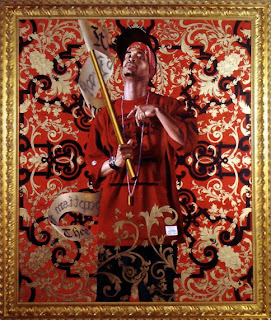Conceptual Art is about the idea. The idea or the concept behind the work is the most important aspect. It means that all of the decisions and planning are made beforehand and the execution is a perfunctory affair. I think that Kapoors work would be classed as conceptual art. To me her work is a mix between architecture and sculpture, she creates large structures of undefinable shapes giving them new meaning and portraying them in unique ways. A lot of planning and pre decisions would have to have been made and highly thought through to make any of her work succeed. I do believe it is conceptual.
"art that is intended to convey an idea or concept to the perceiver and need not involve the creation or appreciation of a traditional art object such as a painting or sculpture." Conceptual Art definition from thefreedictionary.com, (2011).
2. Research 3 quite different works by Kapoor from countries outside New Zealand to discuss the ideas behind the work. Include images of each work on your blog.
'Tall Tree & the Eye' Kapoor (2009)
This amazing sculpture was a piece done by Kapoor which was located in Bilbao, Spain. It is made up of eighty giant spheres all on three axis'. They stretch up, streaming glassy bubbles, each reflecting itself, its neighbor, and all the components making up the tower. As your gaze moves up the tower all of the angles change. At first it looks like all of the bubbles have been placed at random, but that is part of the illusion. In reality it is the result of a carefully calculated, complex mathematical solution which brings to life reflections that appear to be slipping and sliding. The idea behind was to convey the transient nature of how things appear. Kapoors complex use of light & shade with volume & space makes us aware of the instability of the visual world.
'Yellow' Kapoor (1999)
This next piece is called 'Yellow' which was done in 1999. It is a very weird but interesting and mind boggling work, our entire eye is taken up by this singular experience of one colour. The more you look at it, the less you understand, and the depth of the image becomes a blur. By blurring the space between the object and the subject, Kapoor has made our eyes begin to operate in a similar way by pulling in and pushing out. He describes it like this; "Its that phenomenological shift that brings uncertainty, that asks the question about what it is we're looking at." Kapoor (2010). The work 'Yellow' is a work that demands out full engagement and impels us to ask questions.
'Cloud Gate' Kapoor (2004)
Cloud gate was Kapoor's first public sculpture in the United States which was finished in 2006. It is located in Chicago, costing $23million and is washed twice a year with 40 gallons of liquid tide. The sculpture's surface reflects and distorts the city's skyline, kind of turning into a futuristic timeline when you see it in real life. Visitors are able to walk around and underneath Cloud Gates 4 metre high arch. The name was given by Kapoor because eighty percent of what it reflects is sky. Being inspired by Liquid mercury, he created it to be interactive. It lets the viewer become a part of the art, letting the simple act of walking, turning or even just swaying change the visual presented by the sculpture.
3. Discuss the large scale 'site specific' work that has been installed on a private site in New Zealand.
The large scale 'site specific' work shown above was installed on a private site in New Zealand. It was installed in an outdoor art gallery in the North Island called 'the farm'. It was specifically created for a 1000 ac farm owned by a man called Alan Gibbs'.
4. Where is the Kapoor's work in New Zealand? What are its form and materials? What are the ideas behind the work?
This work was done specifically for 'the Farm' which is a large outdoor art gallery on a 1000 acre farm owned by Alan Gibbs. The sculpture was named after its site. The Farm is located in Kaipara Bay on the Kaipara Harbour which is just north of Auckland. Being Kapoor's first outdoor sculpture in fabric, and also because of its location in direct route of the high speed inland winds from the Tasman Sea, it needed to be highly environmentally friendly and withstandable. The structure is fabricated in a deep red PVC coated custom polyester fabric supplied by Ferrari Textiles. It is supported by two identical matching red structural steel ellipses that weigh over fourty tones each. Like many of his other works, Kapoor's intentions with 'the Farm' were to play with the viewers mind. He was quoted from saying “I am interested in sculpture that manipulates the viewer into a specific relationship with both space and time.” Anish Kapoor, Tate Magazine, July 2007.
5. Comment on which work by Kapoor is your favourite, and explain why. Are you personally attracted more by the ideas or the aesthetics of the work?
'Cloud Gate' Kapoor (2004)
My favourite work of Kapoor's would have to be 'Cloud Gate'. This work intrigues me in a lot of ways but I really appreciate how he has used it to bring a hole city together with one idea. The sculpture has had a massive impact on the city of Chicago, every different person who has been in contact with the cloud has made different connections and had an experience that they will most likely not come across anywhere else. I think it could be one of the most successful interactive sculptures of its time. I have always wanted to go to Chicago for a few different reasons, but one of the main ones is to visit the Millennium Park to see and embrace the 'Cloud Gate'.
www.thefreedictionary.com/conceptual+art
http://www.guggenheim-bilbao.es/microsites/anish_kapoor/secciones/galeria_imagenes/
http://en.wikipedia.org/wiki/Cloud_Gate
http://www.chicagoarchitecture.info/Building/636/Cloud-Gate.php
http://fabricarchitecturemag.com/articles/0110_sk_sculpture.html





_from_east%2527.jpeg)

















